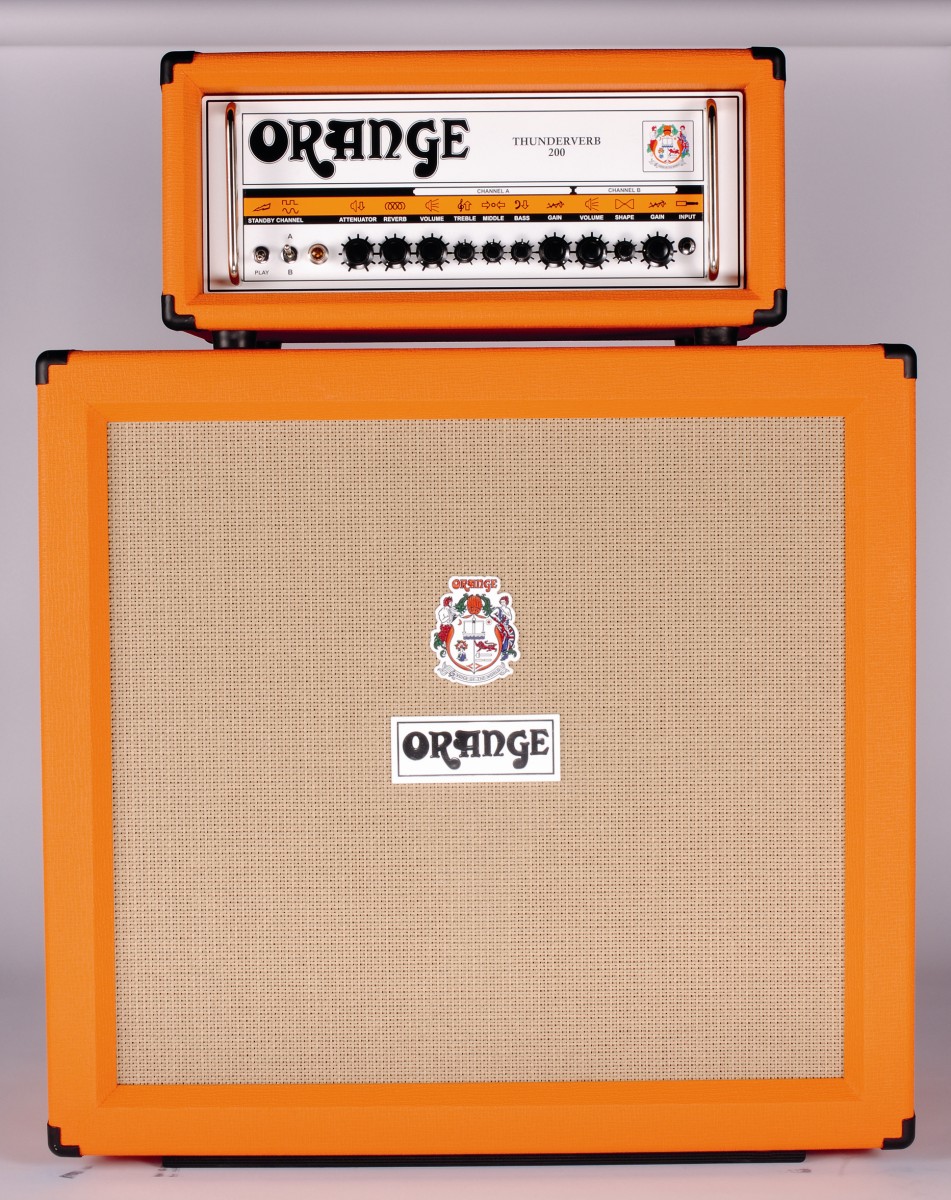MusicRadar Verdict
The 200-watt Thunderverb valve head is not only at home on huge stages; for a studio musician or producer, the combination of built-in attenuation and world-class guitar and bass tones will prove very tempting.
Pros
- +
Range of fabulous sounds with guitar or bass. Attenuation is a masterstroke
Cons
- -
The price may put it out of reach for some players
MusicRadar's got your back

Orange Thunderverb 200 Head




We'll admit to raising an eyebrow at the Thunderverb's 200-watt specification and wondering exactly who really needs 200 valve watts these days? That said, with a half-power mode, built-in attenuation and bass-amp functionality, there's clearly much more to the Thunderverb than a big power stage.
Although the preamp valve complement is identical to Orange's Rockerverb 50 and 100 heads, the Thunderverb has three gain stages on each channel, rather than a four-gain-stage lead channel and more traditional clean/dirty channel configuration. This means that each of the Thunderverb's channels has the same amount of preamp gain on tap, so unlike the majority of twin-channel, high-gain amplifiers, channels A & B here aren't simply dedicated clean and dirty channels.
The main distinction between channels is found in the way that each channel's individual EQ allows you to sculpt its sound. Channel A's complement of treble, middle and bass controls are characteristically powerful - completely killing the sound when all three are set hard left - while channel B features a 'shape' control that acts like a mid contour, scooping the EQ as you twist it clockwise and boosting the extremities of treble and bass. Towards hard left gives you mid-spiked 'vintage' and hard right offers 'modern' hi-gain.
Equipped with 6550 power valves, the Thunderverb can also run KT88s or a pair of each, which opens up some interesting possibilities for tone shaping. Attenuation defeat, channel switching and reverb on/off are all footswitchable, and each can be controlled via a standard latching footswitch.
The Thunderverb's innards are housed in a chunky, confidence-inspiring birch ply casing that's identical in dimensions to the Rockerverb heads, and approximately 40mm deeper than the 30-watt AD series units. We hooked up the Thunderverb head to Orange's new stereo PPC 412HP8 cabinet (UK RRP £699) that features a quartet of Celestion G12100K drivers.
Unconventionally, when run in stereo, the speakers split into two 16-ohm, 200-watt diagonal pairs. Orange designer Adrian Emsley explains: "We preferred the sonic spread of this diagonal speaker configuration when used with two heads and a Space Echo."
In use
Want all the hottest music and gear news, reviews, deals, features and more, direct to your inbox? Sign up here.
Beginning with channel A, we managed to quickly dial in a delicious, slightly foggy clean tone with the volume wound up and the gain backed off to around 10 o'clock that absolutely loves a Strat neck pickup and Little Wing-style embellishments. Add a touch of reverb and it gets even sweeter, with everything from a touch of ambience to a pretty authentic Albatross-style depth around half way, right up to the illusion of a church-like cavernous space on full that works really well with volume swells.
Cranking up the gain and backing off the 'verb, with a PAF-style bridge humbucker the sound is quickly in classic rock territory, moving from Oasis-style singing chords that retain note definition even with complex voicings, through an Angus Young metallic grind into more aggressive alt-rock levels of dirt. The sound is truly majestic throughout and is the definition of mush-free overdrive.
Switching to channel B provides more of the same, with the shape control below 12 o'clock. Winding up the shape control sees the dirt take on a more scooped characteristic without becoming too hollow or fizzy, just like a good modern Mesa Boogie when you get the EQ right. Palm-muted metal riffs get pretty scary here, in the best possible way.
Footswitchable attenuation really gives you somewhere to go in a live scenario when you need a volume boost for solos. Whereas a stompbox booster into a cranked valve amp at stage levels may add more compression and drive but not necessarily the required volume hike, switch out the attenuation and you can set it up to give a serious jump in level and headroom if desired. The untamed power section allows languid lead runs to sing out, and notes to bloom into feedback.
Switching to an old P-bass, the Thunderverb possesses an instant classic valve-bass tonality that manages to sound both warm and defined, huge and tight, with a grin-inducing growl emerging as you turn the gain control clockwise, up to a Nick Oliveri-style QOTSA graunch and beyond.
Due to its three-part EQ section, we found that channel A worked best for setting up our main bass sound. Channel B is then great for kicking in either a wall of fuzzy power or a fat dub sound, depending on the interplay between the immensely powerful shape control and the amount of gain dialled in.
The attenuator and 100-watt mode allow you to get some great overdriven bass tones, but 200 watts and zero attenuation should guarantee all the headroom you need in a live situation too. Our overall impression is that the Thunderverb would definitely make an impressive dedicated bass amp in its own right. Okay, so there's no multi-band graphic EQ or onboard compression, but that isn't likely to enter the equation when you hear just how juicy this amp sounds.
Guitarist is the longest established UK guitar magazine, offering gear reviews, artist interviews, techniques lessons and loads more, in print, on tablet and on smartphones
Digital: http://bit.ly/GuitaristiOS
If you love guitars, you'll love Guitarist. Find us in print, on Newsstand for iPad, iPhone and other digital readers
